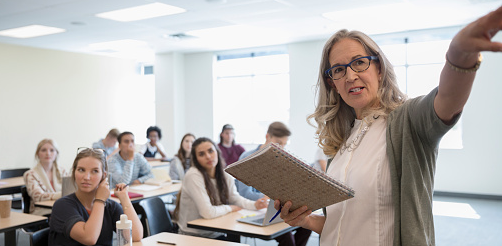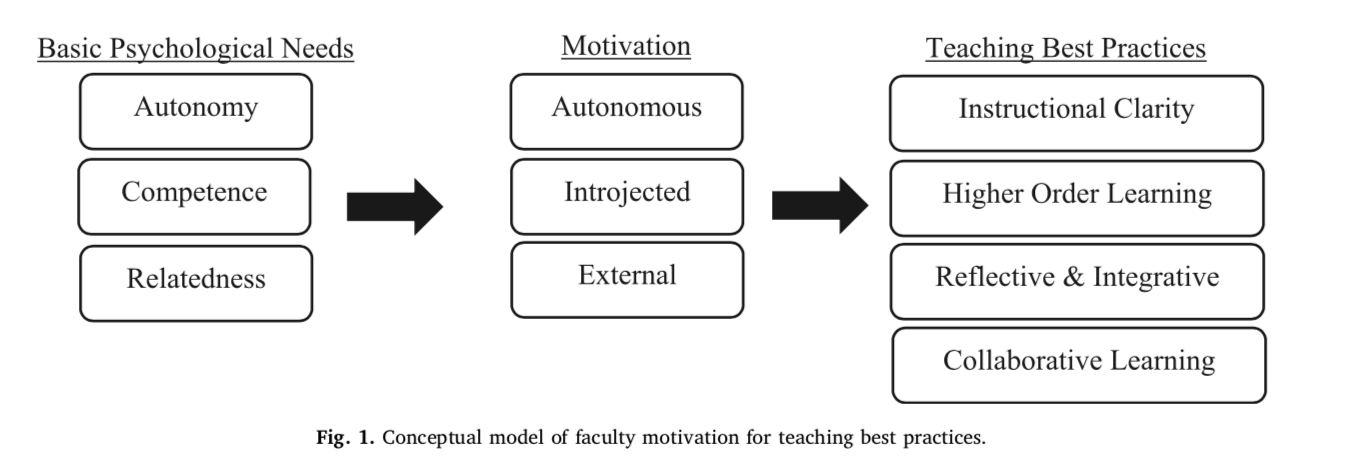You have /5 articles left.
Sign up for a free account or log in.

Getty Images
Whether it’s talking to colleagues, reading the latest research or visiting a teaching and learning center, professors have places to turn to learn about best pedagogical practices. Yet faculty members in general still aren’t known for their instructional acumen. Subject matter expertise? Yes. Teaching? Not so much.
Of course, many professors do teach well, and a new study explores what motivates them to do so. More precisely, the study’s authors wanted to test a model of faculty motivation for teaching as a predictor of using best teaching practices. They also wanted to know what motivates professors at different institution types -- bachelor’s, master’s and Ph.D. granting -- to teach.
As it turns out, certain factors predict professors’ intrinsic and “identified” motivation for teaching (the latter form meaning doing something because it's seen as important), in support of the authors’ conceptual model. And those kinds of “autonomous” motivations in turn predict greater use of proven, effective teaching methods -- namely instructional clarity and higher-order, reflective and integrative, and collaborative learning.
“Simply put, faculty who teach because they enjoy and value it tend to teach in the most effective ways,” said Robert H. Stupnisky, the study’s lead author and an associate professor of education and human development at the University of North Dakota.

Source: Robert Stupnisky
Other types of motivation, meanwhile -- such as seeking external rewards, satisfying self-esteem or avoiding shame, guilt or punishment -- have little to no relationship with best teaching practices, based on the study.
Interestingly, despite the common notion that professors at doctoral institutions see teaching as a distraction from their research, the study found no differences in levels of autonomous motivation or its link to best practices across institution types.
Professors from doctoral, master’s and bachelor’s institutions “are similarly motivated by their enjoyment and value of teaching,” Stupnisky said.
Why does it all matter? Institutional efforts to improve teaching should focus on nurturing faculty members’ autonomous motivation, the study says.
“We recognize that some faculty may never be intrinsically motivated to teach (i.e., teaching because of inherent enjoyment),” reads the paper, “yet the models showed identified motivation for teaching (i.e., teaching because of believed importance) were equally effective in predicting best teaching practices among faculty, which may be a more reachable goal for faculty development.”
Recommended strategies to optimize motivation for teaching include offering faculty choice in course selection as well as teaching content and style. The study also suggests offering professional development workshops and adequate teaching preparation time, along with creating ways for faculty members to connect with students and colleagues.
Fostering Faculty Teaching Motivation
“Faculty Members’ Motivation for Teaching and Best Practices: Testing a Model Based on Self-Determination Theory Across Institution Types,” published in Contemporary Education Psychology, is based on select data from the 2016 national Faculty Survey of Student Engagement concerning 1,671 faculty members from 19 institutions. (The full survey involves many thousands more respondents.)
For their conceptual model, Stupnisky and his co-authors drew heavily on self-determination theory. That’s a framework for thinking about personality and motivation based on the idea that people can function optimally in a given setting when their basic psychological needs are met.
The psychological needs underpinning self-determination theory are competence, “relatedness” (interaction with others) and autonomy. So the supplemental questions on the faculty survey that are the basis of the new study asked respondents whether, for example, they agreed that “I have a sense of freedom to make my own choices,” “I have confidence in my ability to do things well” and “I am supported by the people whom I care about (students, colleagues, etc.).”
The survey included other questions that gauged respondents’ motivation for teaching (“I like to,” “I am paid to,” “I would feel guilty” otherwise and more). It also asked about use of high-impact practices, such as how much a professor’s course work emphasizes “analyzing an idea, experience, or line of reasoning in depth by examining its parts.”
Conversations about self-determination theory typically involve four kinds of motivation: intrinsic, extrinsic (reward or consequence based), introjected (a kind of negative, internal motivation related to guilt), and identified. Noting links between intrinsic and identified motivation, Stupnisky and his co-authors considered them together in their main analysis under the umbrella of “autonomous” motivation.
In an advanced analysis, the authors found that all three basic psychological needs -- competence, relatedness and autonomy -- when met, had significant, positive effects on autonomous motivation, with autonomy having the largest effect. But those needs did not significantly predict introjected or external motivation.
Consistency Across Institution Types
Autonomous motivation had significant positive predictive effects on all four teaching outcomes, across institution types. There was also little difference in levels of that motivation from four-year to doctoral institutions.
Professors at doctoral universities did report slightly greater satisfaction of autonomy, competence and relatedness, as well as more external motivation, the paper says. But respondents reported the same levels of autonomous motivation.
The findings "contradict some assertions that faculty at research-intensive doctoral and master’s institutions are less or detrimentally motivated to teach," the article asserts.
Stupnisky has previously used self-determination theory to study the predictors of pretenure faculty success. He said the new study demonstrates that the right kind of motivation “matters in how faculty teach.” But attempting to motivate faculty “through guilt or rewards” is unlikely to result in better teaching practices.
Meg Gorzycki, a faculty developer and consultant at San Francisco State University, said the finding that autonomous motivation is consistent across institution type (bachelor’s, master’s, doctoral) rings true with her experience. However, she said, the variables that impact instructors’ desire “to learn about and use best practice are heavily weighted on practical matters, such as time and incentives.”
Touching on a design flaw the study itself acknowledges -- that respondents were overly representative of full-time professors compared to the national reality -- Gorzycki said that on many campuses, part-time lecturers outnumber tenure-track faculty. As a result, they have a different relationship to the institution and frequently do not attend workshops and do not participate in the departmental development of programs and curriculum.
Many lecturers nationwide work at two or three different institutions, she added, “and so have little time to learn new strategies of instruction or spend lots of time reading essays or preparing new lessons.”





